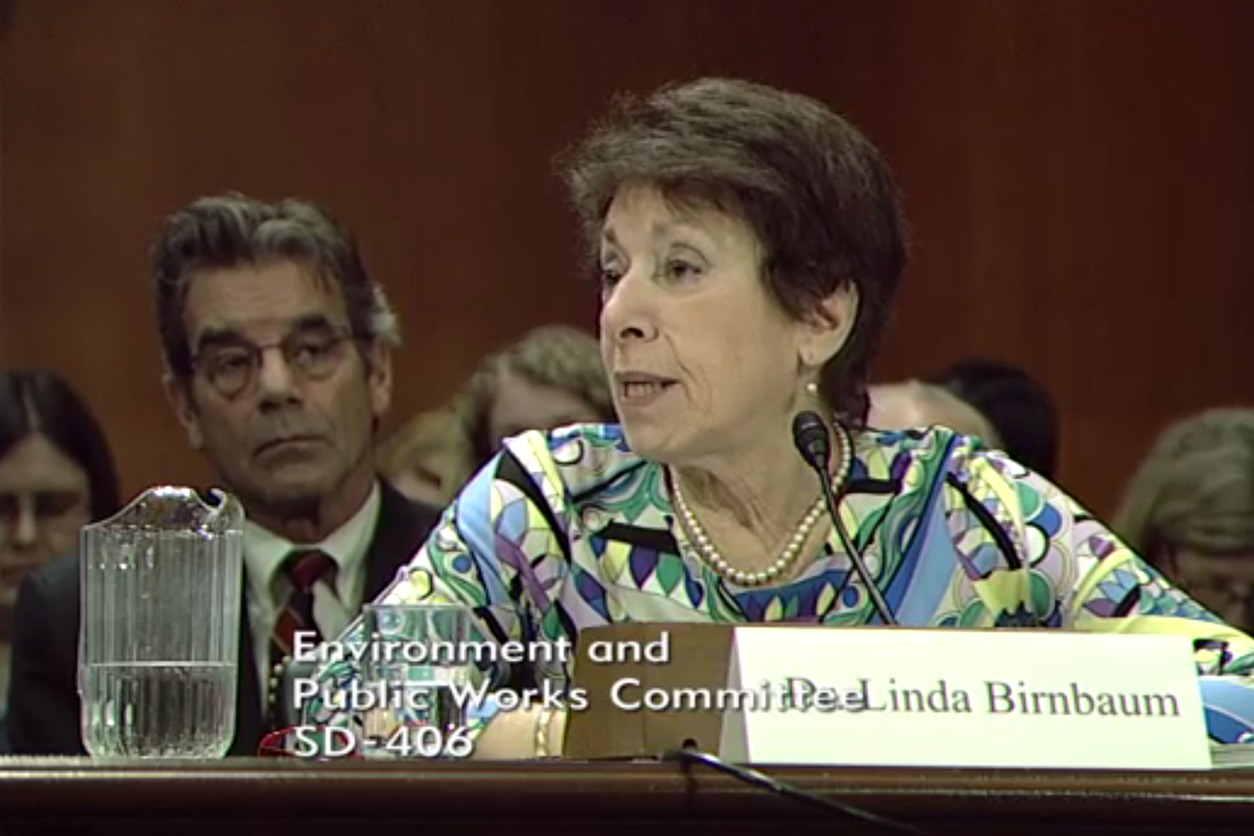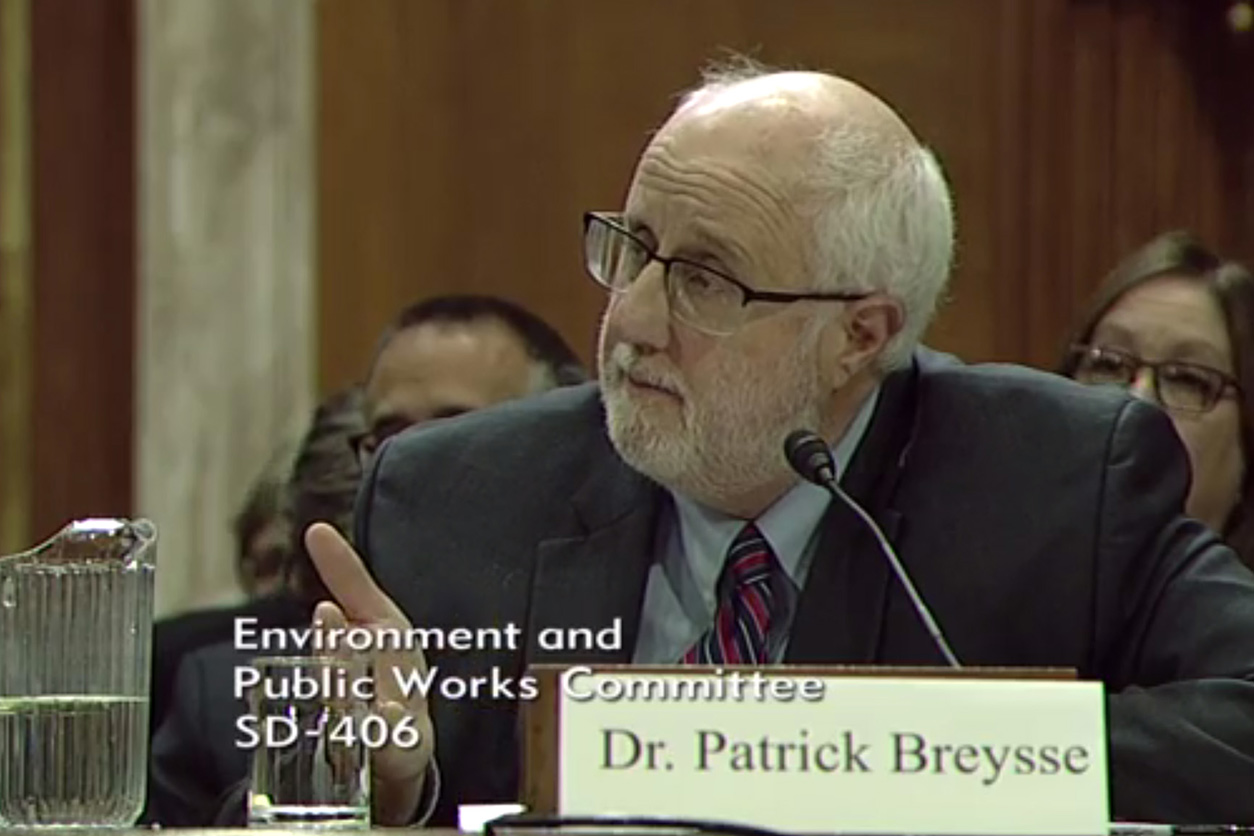Congressional interest in the class of chemicals known as PFAS, or per- and polyfluoralkyl substances, continued last month with a March 28 hearing of the Senate Committee on Environment and Public Works. Among the federal leaders called to testify was NIEHS and National Toxicology Program (NTP) Director Linda Birnbaum, Ph.D., who provided a scientific perspective on the chemicals.
PFAS include thousands of different compounds that are used in waterproofing, firefighting foam, food packaging, and many other applications.
 “PFAS are extremely persistent in our environment, they are transported globally with widespread human exposure, and we are learning more each day about PFAS toxicity,” Birnbaum testified. (Photo courtesy of U.S. Congress)
“PFAS are extremely persistent in our environment, they are transported globally with widespread human exposure, and we are learning more each day about PFAS toxicity,” Birnbaum testified. (Photo courtesy of U.S. Congress)Nearly every state affected
Committee Chairman Senator John Barrasso, M.D., from Wyoming opened the hearing. “Scientists have detected PFAS pollution in nearly every state. It appears to be concentrated in communities adjacent to, nearby, or downstream from military bases, from airfields, from airports, from firefighting facilities, and chemical manufacturing and processing facilities,” Barrasso said.
Senator Thomas Carper from Delaware, the ranking member of the committee, underscored the national scope of concern. “PFAS contamination is widespread. It's found in red states, it's found in blue states, in small water systems, in large water systems, from dairy farmers in Maine to Air Force bases in Alaska,” he observed.
Three federal leaders joined Birnbaum at the hearing, to testify and answer questions from senators.
- David Ross, J.D., assistant administrator of the U.S. Environmental Protection Agency Office of Water.
- Maureen Sullivan, deputy assistant secretary of defense for environment, Department of Defense.
- Patrick Breysse, Ph.D., director of the National Center for Environmental Health and Agency for Toxic Substances and Disease Registry at the U.S. Centers for Disease Control and Prevention.
Expertise from years of research
After presenting oral statements, the four leaders answered questions from the senators. Barrasso turned to Birnbaum, noting her scientific expertise. “Dr. Birnbaum, by your testimony, you've been focused on this for an entire career,” he said. “Could you talk about what the most urgent public health questions related to PFAS chemicals are that we need to answer?”
“PFAS … affect multiple tissues in both males and females, of multiple species, at all developmental life stages,” she replied, summarizing the growing body of scientific literature. “It's not just cancer. It's not just effects on the immune system, it's not just effects, for example, on the kidney or the liver, it's also effects on development and reproduction, and pretty much almost every system that you can think of.”
Contaminated water supplies and health
Senator Kirsten Gillibrand, J.D., of New York also asked Birnbaum about health risks. “The problem with all of these chemicals is that the carbon-fluorine bond is extremely difficult to break down,” Birnbaum stated. “So, these are chemicals that are essentially forever in the environment.”
In response to a further question specific to health risks faced by pregnant women and children, Birnbaum mentioned new research linking PFAS with type 2 diabetes and obesity in children, and gestational diabetes in women.
Gillibrand also addressed Breysse, who joined NTP scientist Sue Fenton, Ph.D., at a 2016 community meeting in Hoosick Falls, New York, which is near Gillibrand’s home and had its water supply contaminated with PFAS (see related story).
 Breysse’s agency is developing a multisite national health study. “This study will examine the relationship between PFAS and health outcomes in multiple communities with contaminated drinking water.” (Photo courtesy of U.S. Congress)
Breysse’s agency is developing a multisite national health study. “This study will examine the relationship between PFAS and health outcomes in multiple communities with contaminated drinking water.” (Photo courtesy of U.S. Congress)Complexity of mixtures, emerging science
It is important to approach the chemicals as a class and as mixtures, rather than one compound at a time, Birnbaum said in her oral statement. “While many research projects focus on a single or series of PFAS, current human exposures to PFAS involve complex mixtures, not individual chemicals,” she emphasized. “This reality complicates both the science of exposure measurement and the assessment of health risks.”
Breysse underscored another challenge facing federal regulators. “The science around these compounds, as Dr. Birnbaum mentioned, is emerging rapidly,” he said. “And so, almost as we establish a benchmark … in a matter of months, it may be out of date based on the new science.”
As she concluded her oral testimony, Birnbaum posed a question. “It is time that we ask ourselves: where are these widely used chemicals really needed? Does the value of PFAS use for modern-day convenience outweigh the risks to public health and related health care costs?” she asked. “No matter how we answer that question, one thing is clear — scientific innovation is critical for shifting to safer alternatives.”
Citation: Harris MW, Birnbaum LS. 1989. Developmental toxicity of perfluorodecanoic acid in C57BL/6N mice. Fundam Appl Toxicol 12(3):442–448.









